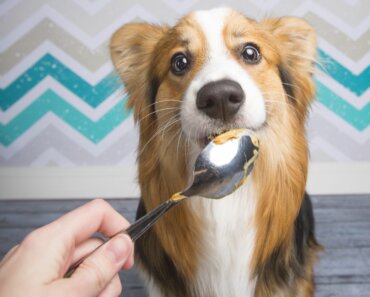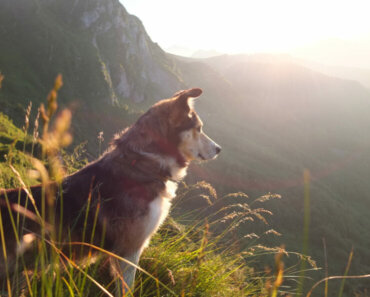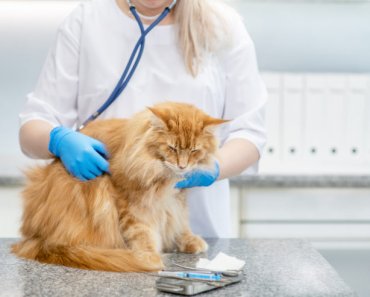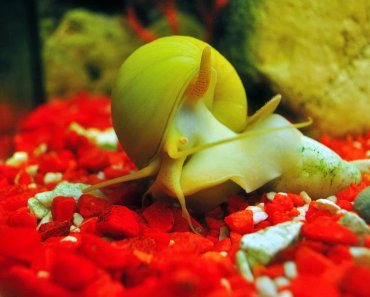An aquarium makes a very relaxing focal point for your home, and fish keeping is a hobby that’s growing in popularity. Children love having pets, but if you don’t fancy the hassle and expense of keeping a dog or a cat, you might want to consider keeping goldfish instead.
Goldfish are pretty easy-to-care-for, and they can live for up to 20 years if properly housed and fed! There are plenty of variations to choose from, and the range of colors and body shapes that you see in the species is astounding.
In this guide, we take a look at the unusual, Bubble Eye goldfish.
Origins
Modern goldfish are thought to be descended from Prussian carp, scientific name Carassius gibelio that’s found in Central Asia. This species of carp inhabit lakes, ponds, rivers, and ditches, where the water is slow or stagnant.
Back in the 1500s, Chinese enthusiasts experimented with breeding the fish, producing many of the fancy varieties that we see today. Goldfish appeared in Europe in the 1600s and in the U.S. in the 1800s.
Today, in total, there are around 125 varieties of goldfish, all of which have been produced through captive breeding.
The Bubble Eye goldfish is sometimes also called the Water-Bubble Eye goldfish and has the scientific name, Carassius auratus auratus. These fish are not listed on the IUCN Red List, as they do not exist in a natural, wild setting.
Appearance
The Bubble Eye goldfish is a quirky looking creature, having an egg-shaped body with a double tail. Most examples of the Bubble Eye lack a dorsal fin, although there is one Chinese variant that does have one.
Like the Celestial goldfish, the Bubble Eye has upturned eyes. However, uniquely, this variety of fancy goldfish develops fluid-filled sacs underneath its eyes once it reaches the age of six to nine months.
Reaching up to five inches in length at maturity, these goldfish with big eyes come in lots of colors, including orange, red, chocolate, black, blue, bi-colors and calicos. In an aquarium or pond setting, these fancy goldfish can live for up to 15 years, with some examples reaching 20 years if correctly fed and well-cared for.
Care guide
Bubble Eye goldfish are a delicate species that are not generally recommended for community tanks or for complete beginners, as they have a low tolerance to pollution. Also, because the fishes’ vision is poor and they are slow swimmers, these goldfish need lots of space, and they won’t do well in tanks with more agile types who will outcompete the Bubble Eye for food.
Also, the fishes’ bubble eyes are problematic in that they can become injured and potentially burst if the sacs become trapped in filter intakes or when the fish are netted. So, for safety, you’ll need to keep the water flow slow and add some soft sponge to cover the intake valve.
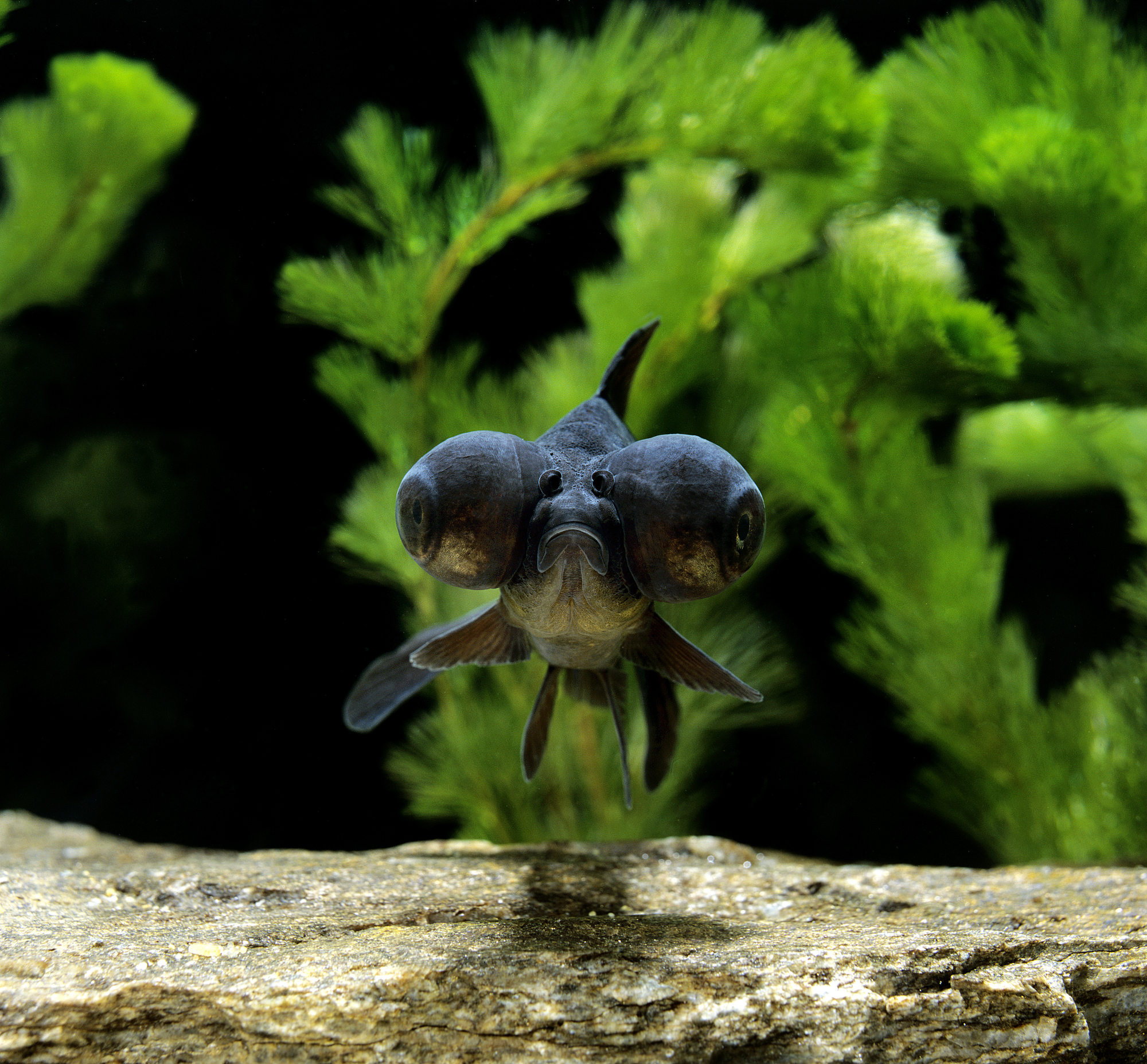
Choosing a tank
The first step to providing the best care for your Bubble Eye goldfish is choosing the correct tank. The size of the tank you pick will depend on how many fish you want to keep.
All fancy goldfish varieties are notorious for producing large amounts of waste. So, you will need to install a highly efficient filtration system. Bubble Eye goldfish need good water quality, so a biological filter system is essential to get rid of the waste, detritus, and leftover food that will otherwise accumulate, damaging the water quality and potentially affecting the health of the fish.
Tank size
One Bubble Eye goldfish will need a tank of at the very least 10 gallons. However, if you plan on adding more fish and you don’t want to upgrade the tank in the future as your fish grows, it’s recommended that you begin with a 20 or 30- gallon tank.
For every additional goldfish that you add to your collection, you’ll need another ten gallons tank capacity. Remember that the more water there is for each fish, the cleaner the water will stay, which is better for the fishes’ health.
Tank shape
Goldfish need plenty of oxygen in the water, so you want to pick a tank that has a large surface area.
The available surface area is determined by the shape of the aquarium rather than by the volume of water it holds. A long tank provides more surface area than a tall one. If you choose a bowl-shaped aquarium, the more water you put in the bowl, the less surface area there is.
How many fish?
One of the challenges of keeping goldfish is deciding how many fish you can fit in your tank. The simple rule of thumb that says to allow one gallon of water per inch of fish is fine for juvenile goldfish, but you will need to allow more space for adults because of the amount of oxygen that they need.
If you try to keep too many fancy goldfish in your aquarium, you risk stunting their growth and stressing the fish, which will most likely lead to disease outbreaks.
So, be very careful not to overstock the aquarium.
Water parameters
Goldfish are coldwater fishes that can live outdoors in ponds. However, fancies, including the Bubble Eye goldfish, do better in an aquarium.
You won’t need a heater, provided that the water temperature remains steady at between 65° and 72° Fahrenheit. It’s important that the temperature remains as constant as possible and that any drops in temperature happen gradually to alleviate the risk of shock to the fish. So, if you live in a region with a very cold winter climate, you should put a heater in your fish tank.
Bubble Eye goldfish will tolerate a wide pH range of between 6.0 and 8.0 and water hardness between 5 and 19 dGH. Goldfish can tolerate slightly brackish water with salinity below 10%.
To keep the water clean, you will need a very good filtration system if you plan on keeping these big eye goldfish. The flow throughout the tank should be moderate, and you will need to fit a piece of soft filter sponge over the filter inlet valve too. The fluid-filled sacs that for the bubble eyes of the fish can get sucked into the filter inlet valve, and have been known to burst. So, a suitable barrier should be fitted to prevent injury to the fish’s eye sacs.
The current in the tank should be slow and carefully balanced so that it provides good oxygenation and efficient filtration, but the flow shouldn’t be so strong that it interferes with the fish’s swimming. Remember that Bubble Eyes don’t have a dorsal fin, and that makes balancing difficult for these fishes.
To keep the water clean, you’ll need to vacuum the substrate every week to get rid of waste and debris, as well as carrying out a 30% to 50% water change.
Aquarium decoration
Bubble Eye goldfish have really poor eyesight, so they need bright lighting so that they can find their way around their environment safely.
Gravel works best as a substrate for goldfish, and you can add a few decorative items to the aquascape too. However, the goldfish’s eye sacs are very vulnerable to damage, so you’ll need to avoid using any items that are rough or sharp, as they could cause injury to the fish.
The ideal setup for these fragile goldfish includes plenty of open swimming space so that they can make their way around their tank without fear of bumping into things. Although lush planting looks great and shows off the beautiful colors and unusual form of these exotic-looking goldfish, they do have a habit of digging around in the substrate and will uproot plants.
Floating species of plants are fine to use, provided that they don’t cover too much of the water surface and can cope with cooler conditions. You could use silk plants instead of real ones, but avoid plastic plants, as their leaves can be sharp and could potentially injure the fishes’ eye sacs.
Diet and nutrition
Goldfish are omnivorous, eating plant matter, vegetables, algae, and meaty foods too.
Bubble Eye goldfish will eat just about anything they are offered, including flakes, pellets, frozen, and fresh foods. Feed the fish a high-quality flake food every day together with some fresh or frozen brine shrimp, daphnia, bloodworms, or tubifex worms as a treat once or twice a week.
You can also use freeze-dried foods, but you need to soak them in some tank water before feeding them to your fish. Also, you must thaw frozen food before offering it to your fish.
Overfeeding your fish is very bad for them and can cause health problems, so feed your Bubble Eye goldfish twice a day and offer them just enough food to keep them busy for a few minutes. Remember that the fish have poor eyesight, so you will need to allow them extra time to eat their ration. Also, watch the fish feeding to ensure that your slow-moving fancies get their fair share.
Tankmates
Ideally, the Bubble Eye goldfish should be kept with others of its own kind. However, goldfish are social creatures that do best when kept in groups.
Because of the Bubble Eye’s poor eyesight and clumsy swimming ability, it’s best to keep them with fancies that are similarly handicapped, such as Telescope goldfish, Black Moors, Celestial goldfish, or Lionhead goldfish.
Breeding
Keen hobbyists with sufficient space and time might fancy trying to breed Bubble Eye goldfish in a spawning tank.
First of all, you’ll need to determine the sex of your goldfish, and that’s not an easy task, especially in round-bodied varieties. Generally, male goldfish are slightly smaller and thinner than females. However, during the springtime breeding season, male fish develop white tubercules or prickles on their gill covers and head, and females appear fat when viewed from above, thanks to the cargo of eggs that she is carrying.
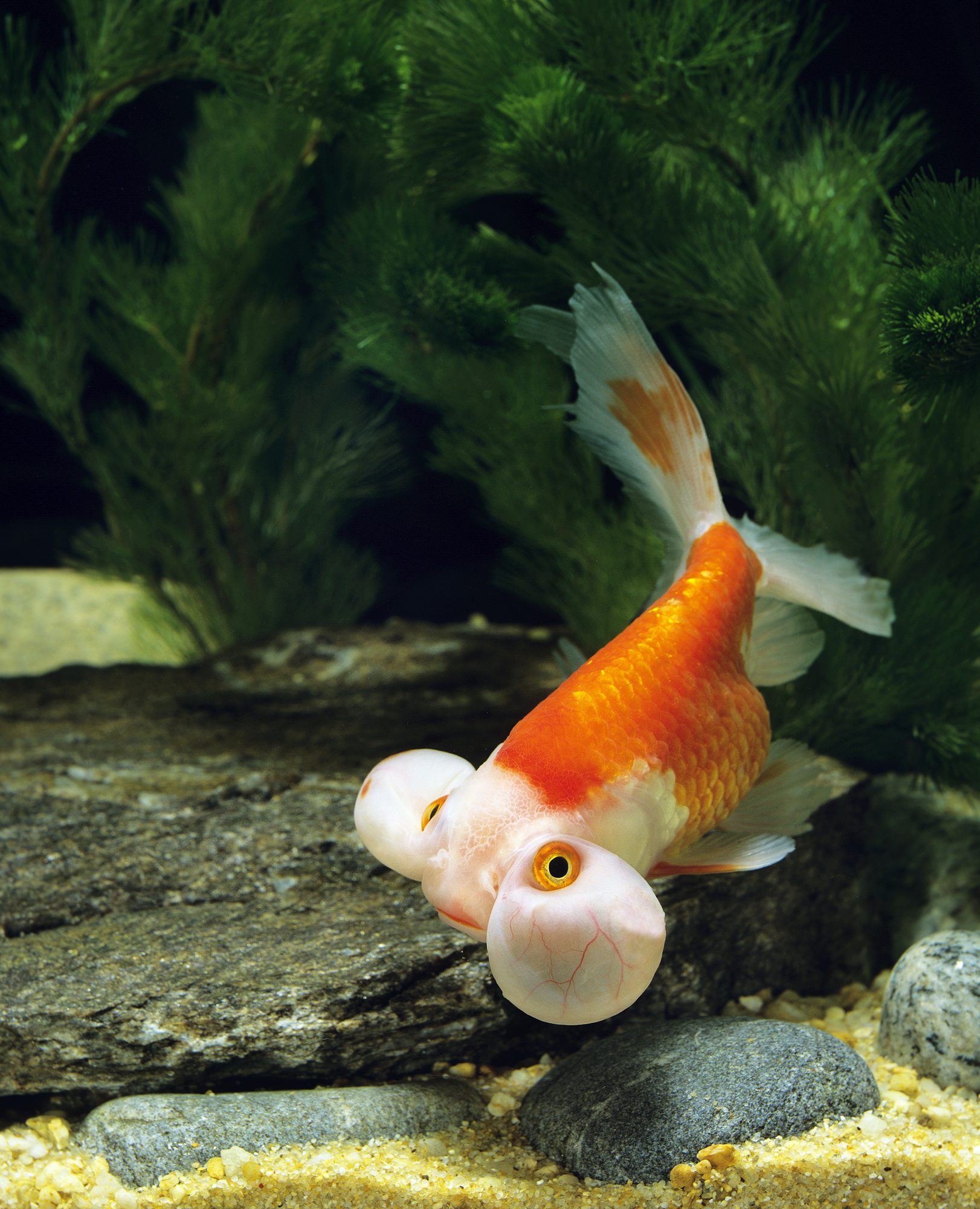
Spawning tank
The best way of stimulating your goldfish to breed is to replicate the conditions in which the fish spawn in nature.
Because goldfish have a tendency to eat their eggs, you’ll need to set up a special spawning tank. The tank should be at least 20 gallons and should have an efficient filtration system. Also, you’ll need to carry out partial water changes of up to 20% every day to keep the water in pristine condition. Include a spawning mop and lots of broad-leaved plants on which the female can lay her eggs
Spawning
If you’re not sure what sex your goldfish are, you can breed them in groups, provided that you have space. Choose your best specimens and check that none of your breeding stock show any signs of disease. Some breeders recommend separating male and female fish for a couple of weeks prior to transferring the fish to the breeding tank. Keeping the males and females apart can help to heighten their interest in breeding later in the process.
Like all goldfish, Bubble Eyes are egg layers. During the springtime, the fish are stimulated to spawn as the water warms up. So, once you’ve placed the fish in your breeding tank, you should gradually reduce the temperature to around 60° Fahrenheit, before slowly warming it again at the rate of 3° Fahrenheit each day until the fish start spawning. Simultaneously, include plenty of live foods in the fishes’ diet and feed them several times each day.
During spawning, the male fish will chase the females around the tank in a non-aggressive way, pushing them up against the plants. Spawning can go on for a few days, during which time the fishes’ color becomes more intense and brighter. The female releases her eggs onto a suitable surface and the male fertilizes them. There can be up to 10,000 tiny eggs laid in one spawn, although not all will hatch.
Once the eggs have been laid, you must remove all the fish from the spawning tank, or they will eat the eggs.
Caring for the fry
The eggs usually hatch within a few days to a week. Feeding the fry is pretty straightforward, as they will eat special goldfish fry food that you can obtain from good fish stores or online. Once the baby fish are large enough, you can give them the same diet as the adults, provided that you crush the food to make it small enough for the youngsters to eat.
You can introduce the baby Bubble Eye goldfish to the main adult collection once they are large enough not to be eaten. The juvenile fish will be dark in color, gradually changing to their adult color as they mature.
Diseases and health
Bubble Eye goldfish are not the hardiest of goldfish species, largely because of their vulnerability to eye injuries. Also, these fish are not the best swimmers, and bumping into things in the aquarium is an ongoing problem.
Also, there are a few common freshwater fish diseases that can affect the Bubble Eye.
Ich
Ich is also known as White Spot disease. The condition is caused by a protozoan parasite called Ichthyophthirius multifiliisthat’s present in most aquariums. The parasite only becomes a problem when the fish are weakened by disease or from living in poor water conditions.
Affected fish flick or rub themselves against objects in the tank and scratch their bodies against the substrate in an effort to remove the parasites from their skin. As the disease progresses, the fish develop a rash of tiny white dots across their skin, fins, and tail. Eventually, the gills become clogged with parasites, and the fish suffocates.
Ich can be treated with over-the-counter treatments that you can buy in most fish stores, and the outcome is positive, provided that you deal with it quickly.
Constipation
All fancies are prone to becoming constipated. Because their round body shape predisposes them to the condition, fish that are fed only on dry food are especially likely to succumb, as the food blocks the digestive tract. Affected fish are unable to swim properly and become unbalanced in the water.
Fortunately, you can fix the problem relatively easily by starving the fish for 24 hours, and then feeding them live food, frozen food, or defrosted peas with the skins removed. If you include a ration of frozen or live food in your fishes’ regular diet, they will be much less likely to suffer from constipation.
Disease prevention
The best way of preventing disease outbreaks in your tank is to keep the water scrupulously clean, maintain the filters properly, and feed a balanced diet to your fish.
Also, before you introduce any new fish to your main tank, you must put them into a quarantine aquarium for about 14 days. Keep a close eye on your new fish for signs of White Spot disease, fungus, and fin rot, and treat any emerging problems right away. Once the fish are free from signs of disease and are eating well, you can put them into your main display tank.
All new ornaments, substrate, and plants must be thoroughly washed before you add them to your tank.
Availability
Bubble Eye goldfish are usually available from fish stores and online. However, this is one of the more unusual types of goldfish, so you may find that you need to order one.
A nice specimen will set you back around $5 per individual, depending on where you buy, and some dealers will offer deals on groups of fish.
Also, if you buy any fish online, you must remember to apply a shipping charge to your order.
Final thoughts
If you’re looking for something unusual to add to your collection of coldwater fishes, the Carassius auratus might be one to consider. We recommend that you have some experience in fishkeeping before taking on one of these, largely because of the possibility of injury to the fishes’ vulnerable bubble eye.
Goldfish care is quite straightforward, as long as you have a large tank with an efficient filtration system, and the water temperature is kept above 60° Fahrenheit.
So, if your children are keen to have pets and you balk at the idea of walking a dog every day or vacuuming up rafts of cat hair from your carpets, why not try keeping a collection of fancy goldfish, including the big-eyed goldfish, Carassius auratus?


